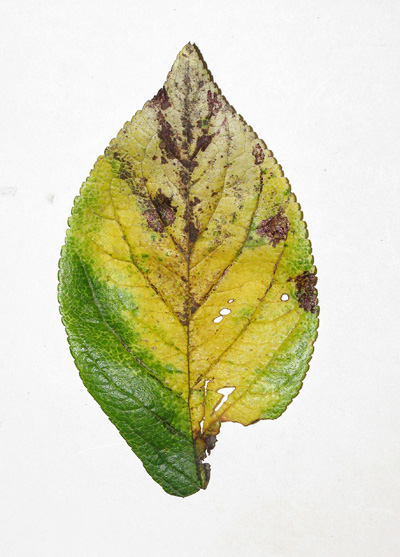Diseases
Pseudomonas syringae pv.morsprunorum (Wormald) Yong et al. - Bacterial Canker of Stone Fruit-trees.
Systematic position..
Kingdom Procaryotae, section Gram-negative aerobic rods and cocci, family Pseudomonadaceae, genus Pseudomonas.Synonyms..
Bacterium mors-prunorum Wormald, Phytomonas morsprunorum Wormald, Agrobacterium morsprunorum (Wormald) Savulescu, Pseudomonas morsprunorum Wormald.Biological group..
Hemibiotroph..Morphology and biology..
Cells of P. syringae pv. morsprunorum are straight bacilli, usually 0.3-0.5 x 0.8-2.5 mkm, moving by means of 1-4 polar flagella. Gram-negative. Not forming capsules. Strains of pathogen grow on potato agar slowly. Colonies are visible in the second or third day only. Colonies are regularly rounded, white, surrounded with narrow transparent opalescent border. Their surface is brilliant with even edges. Diluting gelatin. Not restoring nitrates. Forming levan. Not hydrolyzing starch. Curtailing milk poorly. Not producing indol. Forming acid at fermentation of dextrose, saccharose and glycerin. Optimum temperature of growth is 25°C, maximum 35°C. On trunks and branches of plums, the pathogen forms cancer formations or flat diseased surface, (frequently with cracks), that results in destruction of trees. Leaves get pale-green color with some yellowing, and usually dry up. On apricot, the lesion of leaves is observed as "burn"; on sweet cherry, spotting with yellowish border and loss of leaf tissue is marked. There is also lesion of buds and inflorescences that finally wither and dry up.Distribution.
The bacteriosis presents in the USA, England, Denmark, in the territories of Ukraine, Armenia, Belarus.Ecology.
High temperature (25-30°C) and relative humidity of air (about 90%) are favorable for development of the infection.Economic significance.
The pathogen defeats plum, cherry, sweet cherry, apricot, et al. Control measures include cultivation of relatively resistant varieties, treatment of plants during vegetation by solutions of pesticides and complexes of micro-elements, and careful removal of diseased plant residues.Reference citations:
Bel.tyukova, K.I., Pastushenko, L.T., Oskerko, L.V.1968. Bacterial diseases of fruiters in USSR and their pathogens. In: Bel.tyukova, K.I. et al., eds. Bacterial diseases of plants and methods of their control. Works of the first All-Union symposium on bacterial diseases of plants. Kiev: Naukova dumka, p. 162-176 (in Russian).Bilai, V.I., Gvozdyak, R.I., Kraev, V.G., Ellanskaya, I.A., Zirka, T.I. & Muras, V.A. 1988. Microorganisms are the pathogens of diseases of plants. In: Bilai, V.I., ed. Kiev: Naukova dumka, 552 p. (in Russian)
Grigortsevich, L.N. 1976. Bacterial cancer of fruit crops in conditions of Belarus and development of ways of its control. In: Goncharov, N.D., ed. Potato growing and fruit growing. Proceedings. Vol.1. Minsk: MSKH Belarus SSR, p. 77-81(in Russian).
Grigortsevich, L.N. 1984. Measures of struggle against bacterial cancer of fruits. In: Samersov, V.F., ed. Proceedings. Protection of plants.IX. Minsk: Uradzhai, p. 109-115 (in Russian).
Grigortsevich, L.N. 1994. Bacterial cancer of fruit crops In: Zhogova, E.P., ed. Moscow: Kolos, 44 p. (in Russian)
Gorlenko, M.V. 1966. Bacterial diseases of plants. In: Sokolov, N.A., ed. Moscow: Vysshya shkola, 291 p. (in Russian)
Izrail.skii, V.P., Shklyar, S.N. 1979. Bacterial diseases of plants In: Izrail.skii, V.P., ed. Moscow: Kolos, 288 p. (in Russian)
Shpaar, D, Cleinkhempel, G, Myuller, G. & Naumann, K. 1980. Bacterioses of cultural plants. Handbook Moscow: Kolos, 143 p. (in Russian)


